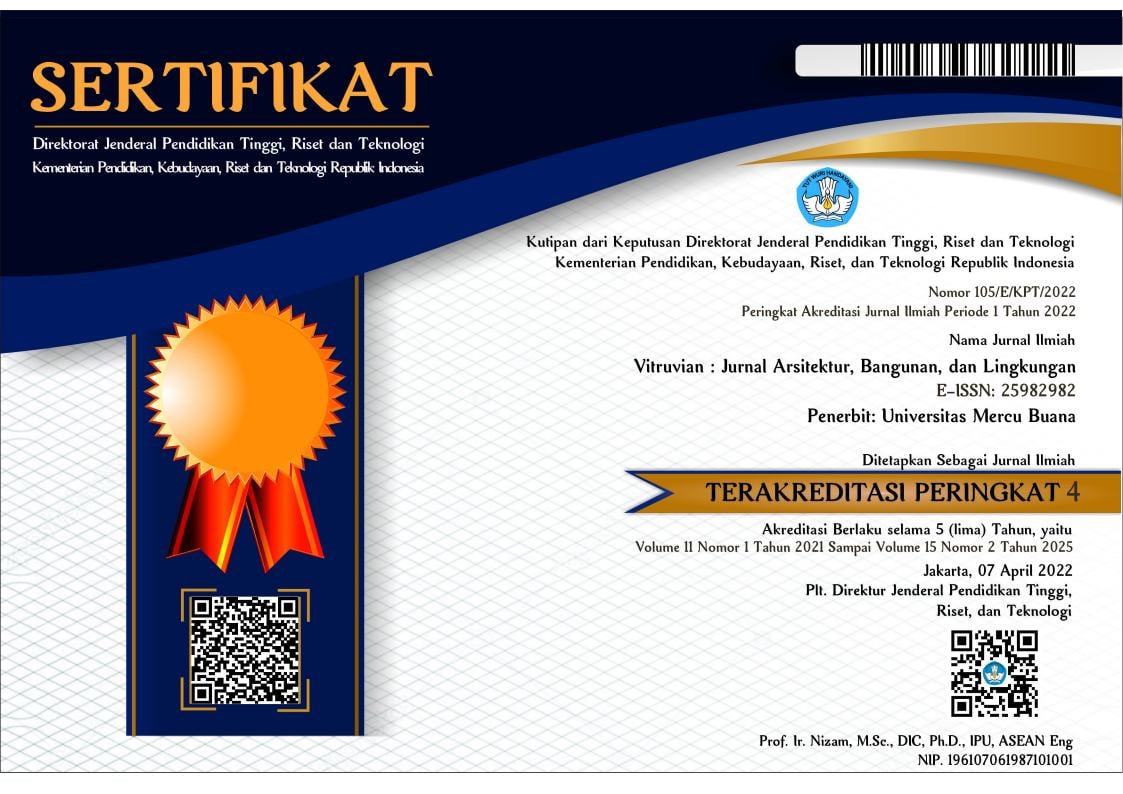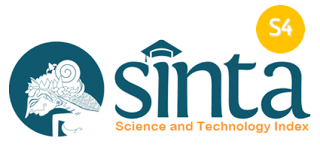IDENTIFIKASI KRITERIA EVALUASI PERANCANGAN RUANG PUBLIK TERPADU RAMAH ANAK (RPTRA) DKI JAKARTA
Abstract
One of the DKI Jakarta Provincial Government's programs, Child-Friendly Integrated Public Spaces (RPTRA), which began in 2015 has been successfully constructed in 324 places. This is the government's attempt to create kid-friendly public area amenities, which previously received little attention. However, as time goes by, several flaws are discovered, including design elements unsuitable for children, unkempt facilities, damaged play equipment, and uneven distribution of RPTRA locations. In 2016, the government has compiled regulation about Space Utilization in RPTRA. However, until now there are no guidelines for evaluating the RPTRA program which has been running for eight years. In order for RPTRAs to continue serving the requirements of the community and to be adequately maintained in accordance with public space standards that are ideal for children, mothers, the elderly, and people with disabilities, this study aims to establish the criteria that must be met in the RPTRA design. It is anticipated that based on the findings of the theoretical study, it will be possible to suggest several criteria for the development and design of the next RPTRA. The research methode is qualitative that involves gathering secondary data from both prior studies and theories concerning the design of public open space that children friendly, and the guidelines from UN Habitat. Then observations were also carried out at an RPTRA to see the condition of facilities that comply with government standart. From the identification, several criteria that must be considered when doing the evaluation, there are spatial and user aspects. Spacial analysis including accessibility, security, safety, facility, vegetation, and health. User characteristic and behavior in RPTRA including comfort, pleasure, and hospitality, are needed to evaluate the design of RPTRA.
Keywords
Full Text:
PDF (Bahasa Indonesia)References
Belekubun, R.A. (2022). Pembenahan Ruang Publik Ramah Anak Terbentur Birokrasi Anggaran. Kompas. Diakses dari https://www.kompas.id/baca/metro/2023/01/30/fasilitas-di-sejumlah-rptra-jaksel-rusak-terkendala-birokrasi (disitasi 27 Maret 2023).
Gehl, J. (2010). Cities for People. Washington DC: Island Press.
Gürer, N., Güzel B.I., & Kavak, I. (2017). Evaluation on Living Publik Spaces and Their Qualities - Case Study from Ankara Konur, Karanfil and Yüksel Streets. IOP Conf. Series: Materials Science and Engineering.
Garau, P. (2016). Global Publik Space Toolkit: From Global Principles to Local Policies and Practice. 2nd rev. ed. Nairobi: UN-Habitat.
Harono H. B. (2023). RPTRA Jakarta sebagai Ruang Dialog Warga. Kompas. Diakses dari https://www.kompas.id/ baca/opini/2023/03/01/rptra-jakarta-sebagai-ruang-dialog-warga (disitasi 27 Maret 2023).
Herlina, N. & Nadiroh. Strategis Ruang Publik Terpadu Ramah Anak (RPTRA) Dalam Rangka Pemenuhan Hak Anak Terhadap Lingkungan. (2018) Jurnal Pendidikan Usia Dini, Universitas Negeri Jakarta Peran.12(1):104-117.
Hernowo, E. (2017). Karakteristik Ruang Publik Terpadu Ramah Anak (RPTRA) Bahari di Kecamatan Cilandak Jakarta Selatan. Jurnal Teknik ITS, 6(2), 567-570.
Ismawati, Y. (2022). RPTRA Masih Belum Bebas Timbal. Kompas. Diakses dari https://www.kompas.id/baca/metro/2022/11/07/rptra-masih-belum-bebas-timbal (disitasi 27 Maret 2023).
Kepala Dinas Pemberdayaan, Perlindungan Anak dan Pengendalian Penduduk Provinsi DKI Jakarta. (2021). Laporan Pencapaian KSD 43 B06. Nomor 2050/-1.88 Tanggal 29 Juni 2021.
Kusumawati, T. (2022). Nasib RPTRA di Jakarta yang Dulu Jadi Kebanggaan Ahok, Kini Mulai Rusak, Besi-besi Berkarat. Kompas. Diakses dari https://megapolitan.kompas.com/read/2022/11/08/05580521/nasib-rptra-di-jakarta-yang-dulu-jadi-kebanggaan-ahok-kini-mulai-rusak (disitasi 27 Maret 2023).
Martinuzzi, C., & Lahoud, C. (2020). Publik Space Site-Specific Assessment. Nairobi: UN-Habitat.
Peraturan Gubernur Provinsi Daerah Khusus Ibukota Jakarta Nomor 139 Tahun 2016 Tentang Pemanfaatan Ruang dalam Rangka Kegiatan Ruang Publik Terpadu Ramah Anak.
PPS. (2022). Placemaking: What If We Built Our Cities Around Places? Project for Publik Space. Diakses dari https://www.pps.org/article/grplacefea (3 April 2023)
Rahmiati, D., & Prihastomo, B. (2018). Identifikasi Penerapan Konsep Ruang Publik Terpadu Ramah Anak (RPTRA) Pada Taman Kambang Iwak Palembang. Virtuvian Jurnal Arsitektur, Bangunan, dan Lingkungan, 8(1):29-42.
Rizal, R. N. (2020). Kesesuaian Taman Kota sebagai Ruang Publik Terpadu Ramah Anak di Kota Bandar Lampung. Tugas Akhir Program Studi Perencanaan Wilayah dan Kota Institut Teknologi Sumatera.
Siregar, J. P., Surjono, Rukmi, W.I., & Kurniawan EB. (2021). Evaluating accessibility to city parks utilizing a space syntax method. A case study:city parks in Malang city. IOP Conf. Ser.: Earth Environ. Sci., 916.
Stephenson, J. (2010). People and place. Planning Theory & Practice, 11(1), 9-21.
DOI: http://dx.doi.org/10.22441/vitruvian.2023.v13i1.004
Refbacks
- There are currently no refbacks.
Copyright (c) 2023 Vitruvian: Jurnal Arsitektur, Bangunan, dan Lingkungan

This work is licensed under a Creative Commons Attribution-NonCommercial 4.0 International License.
Layout Jurnal Vitruvian:Download
Declaration & CTA Form Vitruvian:Download
(WAJIB DI UPLOAD SEBAGAI SUPLEMENTARY SAAT SUBMIT ARTIKEL)
Vitruvian
Program Studi Arsitektur
Fakultas Teknik Universitas Mercu Buana
Jl. Raya Meruya Selatan, Kembangan, Jakarta 11650
Tlp./Fax : +62215871335
Surel : [email protected]
p-ISSN : 2088-8201
e-ISSN : 2598-2982
Website : http://publikasi.mercubuana.ac.id/index.php/virtuvian
DOI : 10.22441/vitruvian
Vitruvian is indexed by the following abstracting and indexing services:

This work is licensed under a Creative Commons Attribution-NonCommercial 4.0 International License.








